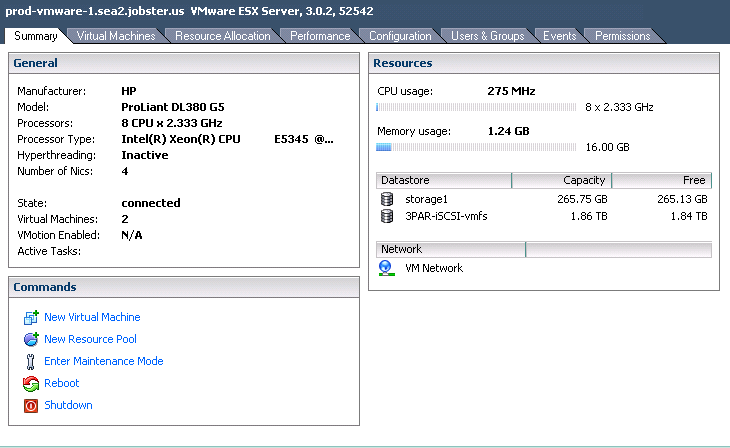Two different stories caught my eye today, one from our friends at The Register about a survey by Veeam Software which surveyed several hundred companies with more than 1,000 employees which came to the conclusion that the average consolidation ratio was 5.1:1.
Across the four geographic regions and all the companies surveyed, the perceived consolidation ratio was 9.8 virtual machines per physical machine. But if you do the math and calculate the actual penetration ration, companies are actually squeezing only 5.1 virtual machines per host on average.
It could just be that some IT managers garbled their responses and have screwed up the data, but perhaps Veeam is on to something.
I saw that and did a virtual face palm. 5.1:1 ? Even 9.8:1 ? I think I was doing about 7-9:1 back in 2007 with my first ESX 3.0 systems on HP DL380 G5s with 8 cores and 16GB of ram. I came across a screen shot of one of those systems a couple weeks ago, brought back some good memories! (oh how iSCSI sucked on ESX 3! Speaking of which that brought up another memory I was at a dinner thrown by Dell I think a year or two ago, and they were pushing iSCSI for Vmware via some 3rd party storage/vmware consultants or something. The presenter kept trying to emphasize at the time how good iSCSI was and how there’s no reason not to use it in Vmware and I kept reminding him(in front of the group) how much iSCSI sucked in ESX 3, which is why people were still hesitant to use it even shortly after vSphere came out, he didn’t take it well, it was funny to watch)
My last VMware projects, always memory constrained of course were at the low end 14:1, and higher end maybe 24:1(64GB ram on hardware circa ~2006 – HP DL585 G1). This was without any benefits from transparent page sharing since that stuff never worked for me on Linux anyways, no swapping either. Just right sizing the VMs to the workloads, even if it meant as little as 96MB of memory for the VM.
My next project I’ll be surprised if we can’t get at least 30-40:1.
Seeing numbers like 5:1 makes me think back to when Vmware went around to their customers and saw what they were actually using before announcing their new price hikes for memory, and they set the license limits to what their typical customer was using.
5:1 ? Sad. Unless your really running a CPU bound application then that’s fine, not many of those out there though.
Second article was this one, where one of the “Godfathers” of Xen said one of the great things about virtualization is improving security with workload isolation.
Isolation — the ability to restrict what computing goes on in a given context — is a fundamental characteristic of virtualization that can be exploited to improve trustworthiness of processes on a physical system even if other processes have been compromised, says Crosby, a creator of the open source hypervisor and a founder of startup Bromium, which is looking to use Xen features to boost security.
I couldn’t agree more, which is why per-VM licensing strategies really piss me off, because it works direct opposition to that strategy. At the very least have dual licensing so customers can license based on VM or based on hardware.
On a side note, I just saw an interesting interview on CNBC, where someone was talking about the IPO of Groupon which I believe is supposed to go live tomorrow. Groupon is apparently trying to raise about $510M in a very paltry offering of something like less than 5% of their company. The funny part is apparently they owe about $505M in short term liabilities to vendors and stuff. The person being interviewed says if Groupon doesn’t pull this off soon they’ll go broke practically overnight.
They are also reporting there are 11 book runners on the deal, more than any other US IPO in history. I don’t know what a book runner is but it sounds fishy to have so many runners for such a small allocation of stock.
Burn, baby, burn.
